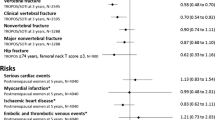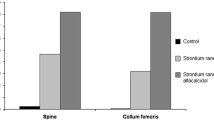Summary
The di-strontium salt strontium ranelate, a novel orally active agent consisting of two atoms of stable strontium and the organic moiety ranelic acid, has been developed for the treatment of osteoporosis. It has been shown to enhance osteoblastic cell replication and increase collagen synthesis while decreasing pre-osteoclast differentiation and bone-resorbing activity of mature osteoclasts in vitro. Studies performed in healthy animals have shown that strontium ranelate not only increases bone mass at various skeletal sites but also improves mechanical properties of femoral, humeral and vertebral bones. In estrogen-deficient animals, strontium ranelate effectively inhibits increased bone resorption while maintaining bone formation. Similar results have been obtained from studies in hind limb-immobilized animals. Strontium ranelate has been investigated in a large phase III program which includes two extensive multinational, randomized, double-blind, placebo-controlled clinical trials for the treatment of severe postmenopausal osteoporosis. Before inclusion in these two studies, patients were subjected to a run-in study in order to initiate normalization of their calcium and vitamin D status. The SOTI study, aimed at assessing strontium ranelate's effect on the risk of vertebral fractures, revealed a significant reduction in the risk of new vertebral fractures in the group treated with strontium ranelate. The TROPOS study, which aimed at evaluating the effect of strontium ranelate on nonvertebral fractures, showed a significant reduction in the risk of new nonvertebral fractures and also, in a high-risk subgroup, a significant reduction in the risk of hip fractures. In both studies, the reduction in fracture risk was accompanied by an increase in bone mineral density. The increase remained significant also after correction of the bone mineral density for the higher atomic mass of strontium compared to calcium. Furthermore, an increase in serum levels of a bone formation marker and a decrease in serum levels of a bone resorption marker were observed. The spectrum of side effects comprised mild diarrhea, particularly within the first weeks of treatment, and also a slightly increased risk of venous thromboembolic events. Strontium ranelate thus appears to be a new, effective treatment to prevent fractures in postmenopausal osteoporosis with a novel mechanism of action. It can be expected for the near future that strontium ranelate will also be evaluated for other types of osteoporosis, such as male osteoporosis.
Zusammenfassung
Die neue, peroral zu verabreichende Substanz Strontiumranelat ist ein Di-Strontium-Salz bestehend aus 2 stabilen Strontium-Atomen sowie dem organischen Anteil Ranelicsäure. Strontiumranelat wurde zum therapeutischen Einsatz bei Osteoporose entwickelt. In vitro steigert Strontiumranelat die Replikation von osteoblastären Vorstufen und die Synthese von Knochenkollagen, während gleichzeitig die Differenzierung osteoklastärer Vorstufen sowie die Aktivität reifer Osteoklasten gehemmt wird. Bei gesunden Versuchstieren führt Strontiumranelat zu einer Zunahme der Knochenmasse an unterschiedlichen Skelettregionen, sowie zu einer Verbesserung biomechanischer Eigenschaften von Femur, Humerus und Wirbelkörpern. Die bei Versuchstieren mit Östrogenmangel beschleunigte Knochenresorption wird mit Strontiumranelat gehemmt, während die Knochenneubildung unbeeinflusst bleibt. Ähnliche Ergebnisse sind auch an immobilisierten Versuchstieren zu beobachten. Strontiumranelat wurde und wird in einem umfassenden Phase-III-Programm untersucht, welches zwei große multinationale, randomisierte, doppelt-blinde, placebokontrollierte Studien zur Behandlung der manifesten postmenopausalen Osteoporose beinhaltet. Vor Beginn dieser Studien nahmen alle Studienteilnehmerinnen an einem mehrwöchigen Kalzium/Vitamin-D-Normalisierungsprogramm teil. In der SOTI-Studie, deren primäres Studienziel die Ermittlung des Effektes von Strontiumranelat auf das vertebrale Frakturrisiko war, zeigte sich in der mit Strontiumranelat behandelten Gruppe eine signifikante Reduktion des vertebralen Frakturrisikos. In der TROPOS-Studie, deren primäres Studienziel die Erfassung des Effektes von Strontiumranelat auf das nicht-vertebrale Frakturrisiko war, zeigte sich in der mit Strontiumranelat behandelten Gruppe eine signifikante Reduktion des nicht-vertebralen Frakturrisikos. Darüber hinaus war in einer Subgruppe mit besonders hohem Frakturrisiko eine Reduktion des Hüftfraktur-Risikos nachweisbar. In beiden Studien war die Reduktion des Frakturrisikos von einer Zunahme der Knochenmineraldichte begleitet, welche auch nach Korrektur wegen des höheren Atomgewichtes von Strontium im Vergleich zu Kalzium signifikant blieb. Weiters war in beiden Studien ein Anstieg eines Serum-Knochenformationsmarkers bei gleichzeitigem Abfall eines Serum-Knochenresorptionsmarkers nachweisbar. Das Nebenwirkungsspektrum umfasst neben vorwiegend zu Therapiebeginn auftretenden Diarrhoen auch ein geringgradig erhöhtes Risiko für thromboembolische Ereignisse. Strontiumranelat stellt ein effektives Therapiekonzept mit neuartigem Wirkmechanismus zur Frakturprävention bei postmenopausaler Osteoporose dar. Eine Prüfung der Wirksamkeit von Strontiumranelat bei anderen Formen der Osteoporose, wie etwa derjenigen des Mannes, darf für die nahe Zukunft erwartet werden.
Similar content being viewed by others
Author information
Authors and Affiliations
Corresponding author
Rights and permissions
About this article
Cite this article
Dimai, H.P. Strontium ranelate: a novel concept for the treatment of osteoporosis. Wien Klin Wochenschr 117, 728–738 (2005). https://doi.org/10.1007/s00508-005-0471-3
Received:
Accepted:
Published:
Issue Date:
DOI: https://doi.org/10.1007/s00508-005-0471-3




